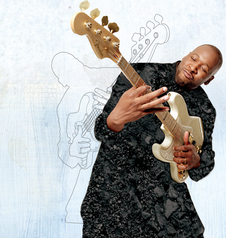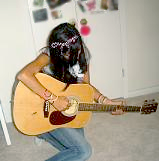35. minor subject
Minors sound dark, sad, or thoughtful, compared with the happy, light, and bright Majors. Minor scales and key signatures relate to the Majors through the Circle of Fifths (which shows their shared flats and sharps).
relative minors
The 'relative' minor scale is related to the Major scale, because it shares the same key signature:
- D Major scale: D E F# G A B C# D
- b minor scale: b c# d e f# g a b

kurt elling & al jarreau
Both scales have 2 sharps: F#C#.
b minor's root is 3 half steps below D Major: D-Db-C-B.
So, to find the relative minor from the Major, go down 3 half steps from the Major. Inversely, to find the Major from the minor, go up 3 half steps, from the minor root.
parallel minors
The parallel minor scale has the same root note as the Major scale:
For the parallel e minor scale, we flatted the 3rd, 6th, and 7th notes. Use this method for any minor scale, keeping the parallel Major's same Root note.
Either relative, or parallel, minor scales can be found from the Major. Relative uses 3 half steps down and the same key signature. Parallel uses the same root, with the 3,6,7 notes flatted. Either method will reach the minor's same key signature, such as g minor:
- relative minor = same key signature as Major
- parallel minor = same root note as Major, and 3,6,7 notes flatted
Minor scales follow this half/whole step pattern:
This step pattern is different from the Major scales.
36. Pentatonic Funk

wayman tisdale
To be the coolest musical cat, get hip to the Pentatonic scale. It seems like every time I hear a catchy song, the band is using Pentatonic chords/scales.
Here's the rundown: Penta-(pent-) means five, and there are 5 tones in its scale, doubling the root (1):
Note, the numbers are the major scale steps.
Major Pentatonic
We skipped some notes that were in the Major scale, to simplify it. Also, it sort of changes the rhythm of the scale, and shortens the climb to the top root. People may like the Pentatonic scale because it's short and simple. To understand better, use your instrument to play the following pentatonics.
Still keep the same Key signature (flats and sharps) that belong with the root (first note) of the scale. Just remove the 4th and 7th notes of a Major scale, to make a Major Pentatonic scale:
Notice the pattern of 123, 56 helps to remember this scale. Practice this 123-56 pattern for every root (1st) note of the Major scales.
Since the "leading tones", the 4th and 7th notes, are removed from the Major scale, it is another reason a Pentatonic scale sounds so cute. Those two notes want to resolve, or "lead to" the next note. A Pentatonic scale gets rid of the middle men.
minor pentatonic
Compare these minor scales' notes to minor pentatonic scales:
Notice there are no 2nd and b6 notes. We removed them from the minor scale, to create our minor pentatonic scale.
- Major Pentatonic = root 2356 (remove 4,7 notes from Major scale)
- minor pentatonic = root b3 45 b7 (remove 2nd,b6 notes from minor scale)

Major and minor Pentatonic scales help to improvise and create a different mood. Switch between the two for flavor. Once this scale's sound is in your head, it's easier to change from a major or minor melody, to a pentatonic, since it has the same key!
The next page explains how to hear complementary sound waves, between two notes, for tuning and keys.